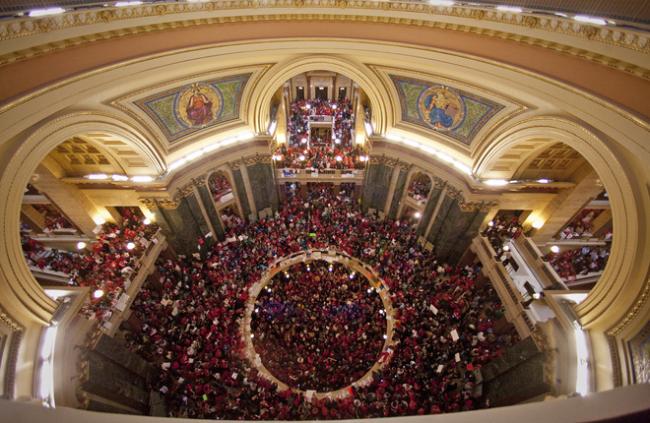Where are the inflationary pressures?
Dispatches (II): Walker rejects union offer to accept concessions
From Milwaukee Sentinel Journal:
…The Walker statement was in response to a statement earlier Saturday from [State senator] Erpenbach, who said he had been informed that all state and local public employee unions had agreed to the financial aspects of Walker’s budget-repair bill. Erpenbach added in his statement that the groups wanted, in turn, for Walker to agree to let labor groups bargain collectively, as they do now.
CBO on HR2, repealing the Patient Protection and Affordable Care Act
From Congressional Budget Office, in a letter dated today:
…CBO and JCT [Joint Committee on Taxation] estimate that, on balance, the direct spending and revenue
effects of enacting H.R. 2 would cause a net increase in federal budget
deficits of $210 billion over the 2012-2021 period ….
The Fiscal Implications of Recent Wisconsin Policy Measures
From the Legislative Fiscal Bureau, roughly analogous to the Congressional Budget Office, an assessment (p.11) that notes the tax revenue implications of three bills implemented under the current Administration:
Analogy Watch: “Cairo has come to Wisconsin”?

Day 3 in the Wisconsin State capitol rotunda. Source: Milwaukee Sentinel Journal
From National Journal:
In an interview on MSNBC’s Morning Joe today, Rep. Paul Ryan, R-Wis., said the cuts were necessary to get Wisconsin back in the black.
“State workers who have extremely generous benefits packages, [Walker’s] asking that they contribute 12 percent to their health care packages. It’s not a lot, it’s about half of what private-sector employees pay, and he’s getting riots. It’s like Cairo has come to Wisconsin,” Ryan said. “People should be able to express their way, but we’ve got to get this deficit and debt under control in Madison.”
Speaker Boehner’s Math
Recently, Speaker of the House John Boehner asserted: “…the federal government has added 200,000 new federal jobs since President Obama took office.” Other analysts have tried to find the source for this figure, but I thought of interest to see exactly how bad his math was.
Money and reserves
I wanted to offer some clarification on stories about all the money that the Federal Reserve is supposedly printing. It depends, I guess, on your definition of “money.” And your definition of “printing.”
Intermediate Macro Exercise: How to Construct a Maximally Contractionary Budget Deficit Reduction
Consider an economy called Käseland, with gross output equal to approximately $475 billion, and unemployment rate of 7.5%, so considerable underemployment of factors of production exists; consistent with this interpretation, the general nonfarm wage rate has been relatively constant, growing at only 1.2% on a 12 month basis through 2010, and the price level has risen by about 1.5% from the second half of 2009 to second half of 2010.
Suppose there is a budget deficit, that you wish to close. How do you maximize the negative impact on output?
Progress report on QE2
We’re now 3 months into the Fed’s new asset purchase program that has been popularly described as a second round of quantitative easing, or QE2. I thought it would be useful to take a look at what has actually changed during the first 3 months of QE2.
The December Trade Release
The December trade figures were released today. The trade deficit widened a bit, largely in line with the Bloomberg consensus, but a little less than assumed by BEA statisticians. This outcome meant a likely revision upward to 2010Q4 GDP. From Lahart/WSJ RTE.